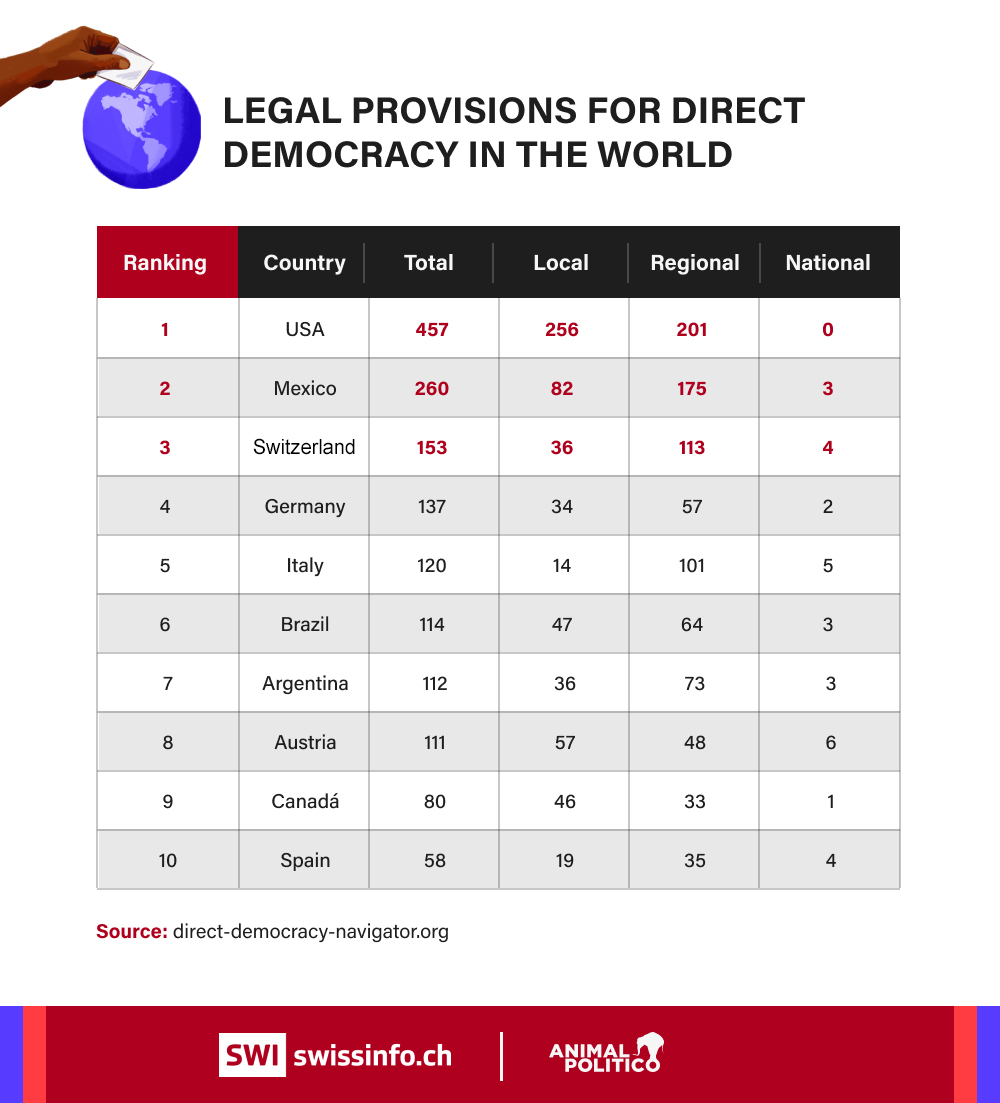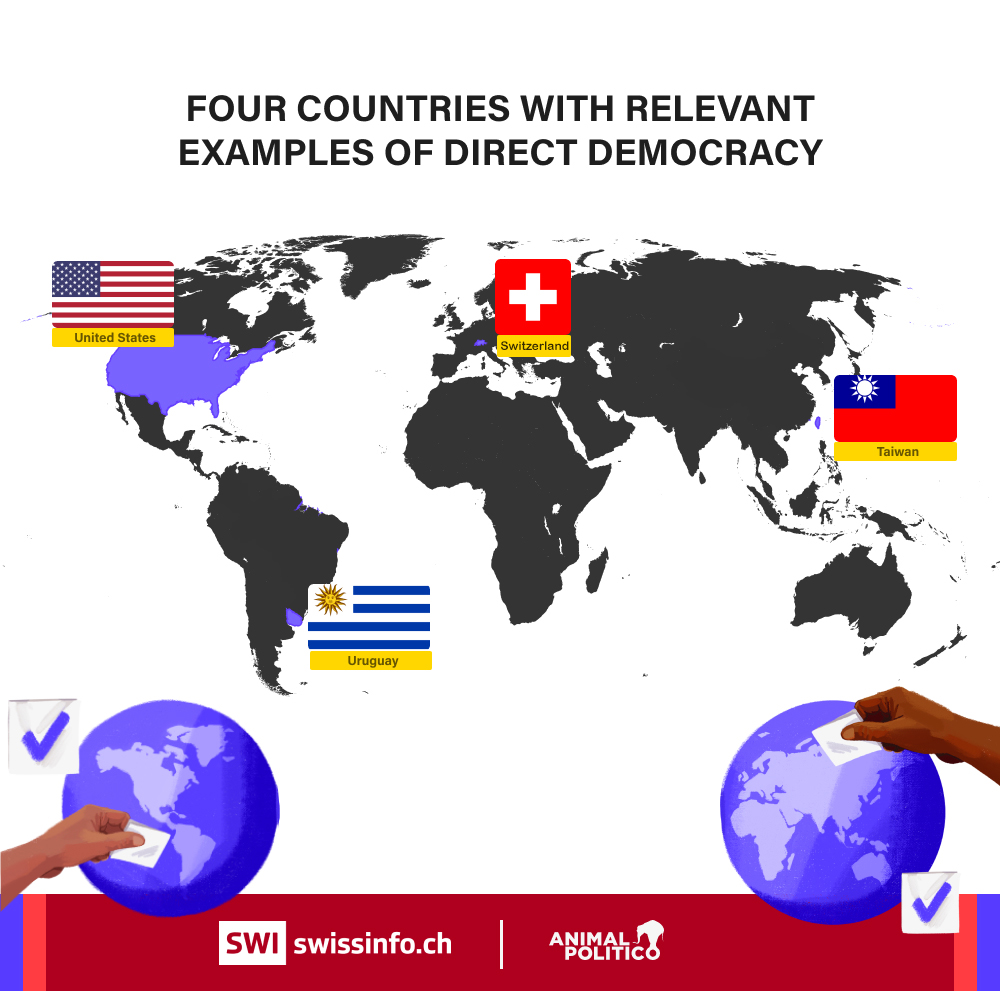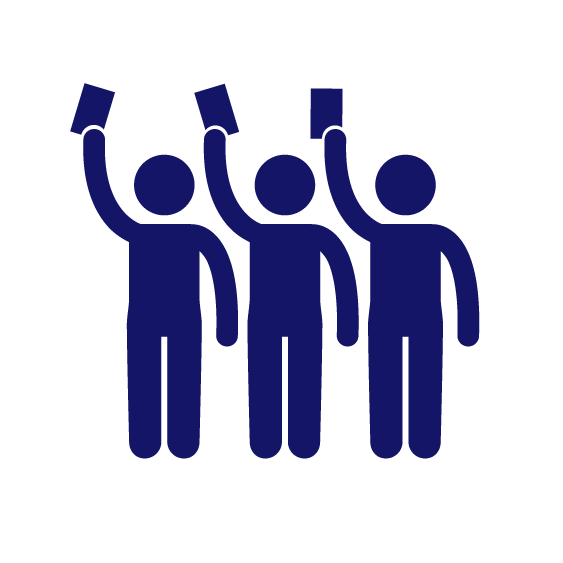
How direct democracy is practised in four countries

Mexico is far from alone in testing new participatory methods beyond representative electoral democracy. Around the world, several countries, cities and regions are providing citizens with direct access to political decision-making. SWI swissinfo.ch highlights four examples.
“We are the people,” protesters on the streets of East Germany shouted back in 1989 as a challenge to the then-communist one-party state. One year later, they had succeeded in overcoming half a century of dictatorship and establishing a united democratic country with West Germany.
Since then, hundreds of millions of people around the world have demanded the fulfilment of a fundamental human right, set out in the 1948 Universal Declaration of Human Rights (Article 21.1): “Everyone has the right to take part in the government of his country, directly or through freely chosen representatives.”

More
How Swiss direct democracy works
“The idea of having ordinary people capable of governing themselves is much older than the UN Human Rights Declaration”, says John Matusaka, a finance professor at the University of Southern California and the author of several books on the role of modern direct democracy in representative government systems. “Popular self-government is an experiment that continues to shape the modern world.”
Although this experiment has sometimes ended in a populist or even autocratic backlash, a growing number of political communities – cities, regions, nation-states and even continents – have been able to establish and implement a large variety of people-led initiatives and referendums in recent years. Some countries, like Switzerland and the United States, have been practising citizen-lawmaking for more than a century. Others, like Taiwan, are relative newcomers to the field and showcase the breadth of participatory democracy tools being applied today.

Taiwan: having a genuine say in politics
The island of Taiwan (36,000 km2, population 23 million) has moved from a democracy on paper to a functioning democracy run by the Taiwanese people, through a process that has accelerated since the 1980s. Today it is a vibrant multiethnic society with 18 official languages.
In 2003 Taiwan introduced its first law on initiatives and referendums. In the last 20 years, the text has undergone improvements and amendments that include a relatively low threshold for forcing a popular vote on proposed legislation. These changes mean that today the people of Taiwan are able to have a genuine say in politics – both at the local and national levels.
In November 2018 alone, more than ten citizen-led proposals, on issues ranging from environmental protection and marriage equality to the international status of the island, were put to a general vote. In 2021 the Taiwanese decided to amend their direct democracy law in a way that voting on candidates in elections and on issues by referendum were separated.
One weakness in the process, however, is the legal requirement for a minimum 25% approval rate among the whole electorate for a proposition to pass. This allows opponents of a proposal to influence the outcome of the vote by simply not participating. In 2021 four referendums were invalidated as they did not reach the approval of 25% among all voters.

Switzerland: a country invented by direct democracy
Historically, the very first ideas for complementing representative government with mechanisms of direct democracy were informed by practices in the United States and Switzerland in the late 19th century.
Switzerland (41,000 km2, pop. 9 million) has often been called a “midwife” of modern direct democracy, which is defined by using secret voting processes in public decision-making opposed to more traditional forms of assembly democracy.

More
The Swiss political system
But that’s wrong for two reasons. First, Switzerland did not invent direct democracy – rather, direct democracy invented Switzerland through a public vote in 1848 to establish the Swiss Confederation. Second, the country did not grant half of the population – women – the right to vote until the 1970s, far later than many democracies around the world.
Yet in the last 50 years Switzerland has fully implemented initiative and referendum mechanisms within the framework of representative government.
Since 1971, Swiss men and women over 18 years of age have been invited to make binding decisions more than 450 times at the national level. More importantly, in contrast to many other political communities around the world, in Switzerland elected legislative or executive leaders are not allowed to put an issue to a public vote: this can only be done by the citizens themselves, either through the collection of signatures or in accordance with a legal requirement, such as proposed changes to the constitution or for important financial expenditures.
Although challenges relating to inclusion remain – more than 25% of the adult population is not eligible to vote, as they lack a Swiss passport – Switzerland offers interesting lessons in how to efficiently combine indirect and direct democracy. External link
American checks and balances
While Switzerland offers a way to reconcile its democracy by having conversations, in the United States (9,8 million km2, pop. 331 million) applying the initiative and referendum process has sometimes led to political clashes.
First introduced in South Dakota and Oregon around 1900, today direct citizen lawmaking is present in one form or another in a majority of US states.
In fact, direct democracy tools have become a powerful check on elected bodies in most US cities, even if at the national level the United States still has not been able to establish direct links between the people and the federal government. This includes the presidential elections, which are fought statewide and administered by an old-style electoral college, which sometimes allow popular minorities to win the presidency.
Direct democracy mechanisms are often used in several states at the same time to push a national agenda, as has happened on issues like animal rights, marriage equality or abortion regulations.
As a fundamental challenge to American politics, the excessive use of money also restricts access to direct democracy, especially in bigger states such as California, where no statewide citizens’ initiative ever made it to the ballot without (highly paid) professional signature gatherers.
Uruguay: Latin America’s democratic model
Further away, the sparsely populated republic of Uruguay (176,000 km, pop. 3,5 million), run as late as 1985 by military dictators, has a history of strong stakeholders in politics and society overcoming their differences and opposition using the tools of direct democracy.
This community-by-diversity approach was powerfully demonstrated to the world when Uruguay sent three official representatives to the inauguration of Brazil’s newly elected president earlier this year: its current head of state, plus two former presidents representing both the left and right in politics. The decision was as a sign that political confrontation is not an obstacle to cooperation in society.
There are just three direct democracy tools available in Uruguay, all on the national level. With comparatively high thresholds for vote results to be considered valid – 10% participation for a citizens’ initiative and 25% for a referendum – they also seem rather inaccessible to ordinary people.
However, having held almost 20 popular votes in the last 30 years, Uruguay has been able to find broadly accepted ways forward on issues including penal law, voting rights, the independence of the judiciary, and the public pension system. This has contributed to making Uruguay the Latin American country with the highest per capita income, lowest poverty rate and lowest level of inequality. In sum, Uruguay ranks as one of the top 15 democracies worldwide, occupying 13th place in the 2023 Economist Democracy Ranking, well ahead of the US (26), Brazil (47), Colombia (59) and Mexico (86).
In Taiwan, Switzerland, the US and Uruguay, direct democracy tools are bottom-up mechanisms that have a binding impact on the legislative process and cannot be used by elected officials to increase their own powers.
These features may well be contributing to a higher trust in national governments. They also show that direct democracy today can take many shapes.

More
Our democracy newsletter
English-language editing by Geraldine Wong Sak Hoi

In compliance with the JTI standards
More: SWI swissinfo.ch certified by the Journalism Trust Initiative

























You can find an overview of ongoing debates with our journalists here . Please join us!
If you want to start a conversation about a topic raised in this article or want to report factual errors, email us at english@swissinfo.ch.